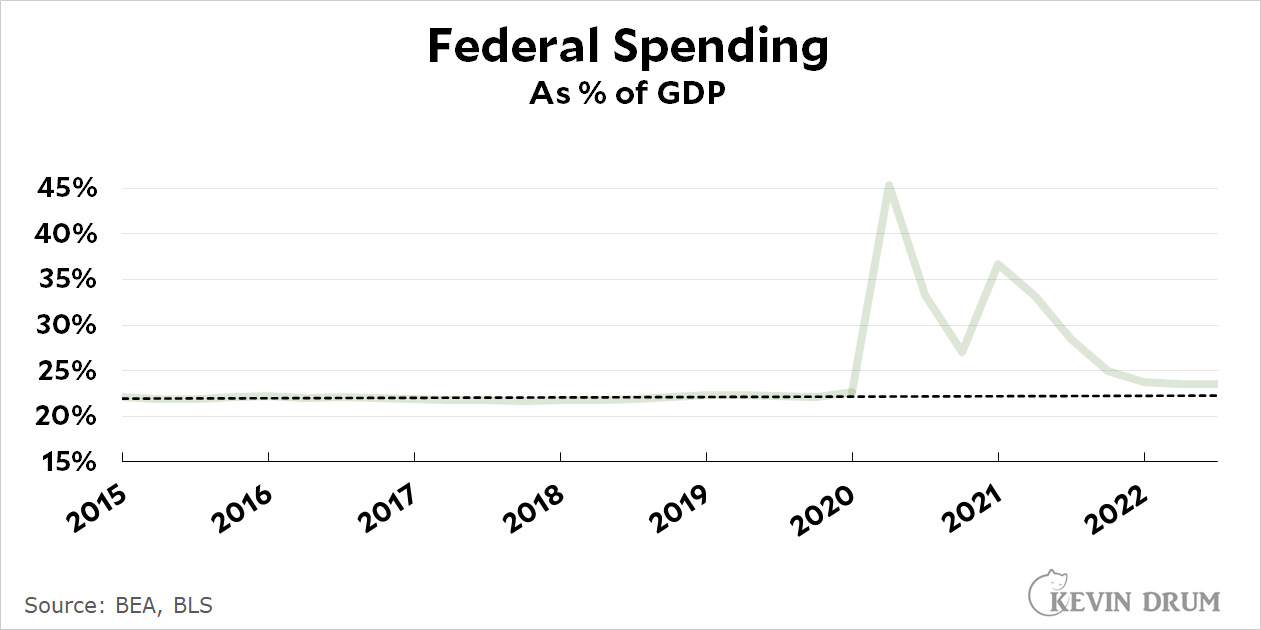For those who want some basic data for the national debate that's likely to unfold once we finally have a Speaker of the House, here is federal spending over the past few years, both before and after the pandemic. As usual, the trendline is for spending prior to the pandemic, extended to the current day so we can compare it to actual current spending.
The basic story is simple: we spent a ton of money during the pandemic and then cut back in 2021 and 2022. We are currently spending at a rate slightly higher than we would have projected back in 2020, on the order of about 1% of GDP. Depending on our priorities, this is something we might or might not want to claw back.


A big question is whether you should adjust for size of GDP. Given that I lean left and think about all the good we can afford to do with government spending, I want to see government spending as a percentage of GDP. Disingenuous conservatives will not adjust for inflation or population or will cherry pick the starting or ending point of the time series; those who are little more serious will point to increases in inflation-adjusted per capita spending to make their argument that big government is out of control.
Start making more money weekly. This is valuable part time work for everyone. The best part ,work from the comfort of your house and get paid from $10k-$20k each week . Start today and have your first cash at the end of this week.
Visit this article for more details.. http://incomebyus.blogspot.com/
How far off the trendline will we be if Kevin McCarthy is held hostage to a balanced budget amendment? Just curious.
We all know the truth, don’t we? …. It isn’t how much is spent. It’s what it’s spent on. Or more precisely, who it’s spent on.
Really enjoying, and recommend:
https://www.amazon.com/Making-Money-Work-Us-America/dp/1509554262/
O/T, but...
Is there any prospect for a rules-change? Do House members even acknowledge there's a problem? What if a national emergency had occurred in early January and legislation were desperately needed? Also, what if this situation had transpired in early 2025: would we have simply delayed certification of the presidential election?
The clown car that is the House GOP makes for a fun occasion to eat popcorn and mock MAGA dysfunction, but there are real constitutional issues at play, and I feel this is yet another blinking neon sign warning us of the dangers flowing from the creakiness of the USA's political-constitutional order.
At minimum they should change the rules to allow members to be sworn in by the clerk. Also, IIRC, members-elect sign an oath when they arrive at the Capitol, so maybe the law (or House rules) could be changed to allow the signature to replace the swearing in. (The public oath-taking ceremony could still take place, of course, in keeping with tradition; its delay simply wouldn't stop House business from occurring, as is now the case).
I'm guessing no reforms will be implemented. Partly because the GOP seems not to be much bothered by government dysfunction (to many of them chaos is a feature, not a bug). And also because Kevin McCarthy is unlikely to support any moves that would make the timely appointment of a Speaker a less pressing matter.
It isn't just the swearing in, it is also that each Congress adopts its rules for the session. While most are longstanding and not controversial, changes are made sometimes, put forward by the Speaker. Little if any business could be transacted before the rules are adopted. If the House attempted to adopt rules that would bind the Speaker before choosing the person to hold that office, it would devolve into a protracted fight over the rules preferred by the various factions.
Any particular reason why the trendline isn’t linear?
The trendline appears to have been changed.
Is the difference between the chart using GDP and the one using per capita that GDP has grown faster than the population?
For posterity, the original version and the different conclusion down there from: https://web.archive.org/web/20230106223259/https://jabberwocking.com/raw-data-federal-spending/
Archive.org early
Archive.org often
This is what shows up in my RSS reader - the original version, I guess. Interesting. Makes sense.
So, logic (and eyes) would tell us that to return to the trendline's rather gradual rise over time until Trump was elected (and admittedly largely beyond him) there will need to be a few years of lower spending. A few more Obama-Clinton years. (Kevin probably feels optimistic.) Historically, before Trump, the trendline would appear-to-have-been more-or-less flat. So, point stands. Federal spending is set at the same rate per capita it's always been. It kills us, but it's just about enough. We survive. Die slowly. All good.
Being of the left-liberal persuasion, I don't think there is any magic to a percent-of-GDP number. Like most of the OECD countries, I see a role for government in insuring citizens against many of the uncertainties of life, particularly those beyond the individual's control, and for which private insurance is unavailable or prohibitively expensive. As well, I support providing a broader range of individual benefits that also benefit the whole society. As increased productivity has grown and will continue to grow GDP per capita, we can afford to provide paid family leave, affordable post-secondary education, universal healthcare, and other programs taken for granted in other developed democracies.